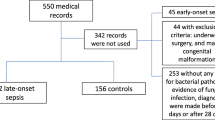Abstract
Late-onset neonatal sepsis (LOS) in preterm infants is an important cause of morbidity and mortality in preterm infants. Since presenting symptoms may be non-specific and subtle, early and correct diagnosis is challenging. We aimed to develop a nomogram based on clinical signs, to assess the likelihood of LOS in preterms with suspected infection without the use of laboratory investigations. We performed a prospective cohort study in 142 preterm infants <34 weeks admitted to the neonatal intensive care unit with suspected infection. During 187 episodes, 21 clinical signs were assessed. LOS was defined as blood culture-proven and/or clinical sepsis, occurring after 3 days of age. Logistic regression was used to develop a nomogram to estimate the probability of LOS being present in individual patients. LOS was found in 48 % of 187 suspected episodes. Clinical signs associated with LOS were: increased respiratory support (odds ratio (OR) 3.6; 95 % confidence interval (CI) 1.9–7.1), capillary refill (OR 2.2; 95 %CI 1.1–4.5), grey skin (OR 2.7; 95 %CI 1.4–5.5) and central venous catheter (OR 4.6; 95 %CI 2.2–10.0) (area under the curve of the receiver operating characteristic curve 0.828; 95 %CI 0.764–0.892). Conclusion: Increased respiratory support, capillary refill, grey skin and central venous catheter are the most important clinical signs suggestive of LOS in preterms. Clinical signs that are too non-specific to be useful in excluding or diagnosing LOS were temperature instability, apnoea, tachycardia, dyspnoea, hyper- and hypothermia, feeding difficulties and irritability.


Similar content being viewed by others
Abbreviations
- LOS:
-
Late-onset sepsis
- NICU:
-
Neonatal intensive care unit
- CVC:
-
Central venous catheter
- AUC:
-
Area under the curve of the receiver operating characteristic curve
- OR:
-
Odds ratio
- CI:
-
Confidence interval
References
Bayak MA (2004) What you see may not be what you get: a brief, nontechnical introduction to overfitting in regression-type models. Psychosom Med 66:411–421
Berger A, Salzer HR, Weninger M, Sageder B, Aspöck C (1998) Septicaemia in an Austrian neonatal intensive care unit: a 7-year analysis. Acta Paediatrica 87:1066–1069
Brodie SB, Sands KE, Gray JE, Parker RA, Goldmann A, Davis RB, Richardson DK (2000) Occurrence of nosocomial bloodstream infections in six neonatal intensive care units. Pediatr Infect Dis J 19:56–65
Conroy ME, Shi HN, Walker WA (2009) The long-term health effects of neonatal microbial flora. Curr Opin Allergy Clin Immunol 9:197–201
Fanaroff AA, Korones SB, Wright LL, Verter J, Poland RL, Bauer CR, Tyson JE, Philips JB 3rd, Edwards W, Lucey JF, Catz CS, Shankaran S, Oh W (1998) Incidence, presenting features, risk factors and significance of late onset septicaemia in very low birth weight infants. Pediatr Infect Dis J 17:593–598
Fischer JE (2005) Physicians' ability to diagnose sepsis in newborns and critically ill children. Pediatr Crit Care Med 6:S120–S125
Franz AR, Bauer K, Schalk A, Garland SM, Bowman ED, Rex K, Nyholm C, Norman M, Bougatef A, Kron M, Mihatsch WA, Pohlandt F, International IL-8 Study Group (2004) Measurement of interleukin 8 in combination with C-reactive protein reduced unnecessary antibiotic therapy in newborn infants: a multi-centre, randomized, controlled trial. Pediatrics 114:1–8
Gerdes JS (1991) Clinicopathologic approach to the diagnosis of neonatal sepsis. Clin Perinatol 18:361–381
Kudawla M, Dutta S, Narang A (2008) Validation of a clinical score for the diagnosis of late onset neonatal septicemia in babies weighing 1000–2500 g. J Trop Pediatr 54:66–69
Mahieu LM, De Muynck AO, De Dooy JJ, Laroche SM, Van Acker KJ (2000) Prediction of nosocomial sepsis in neonates by means of a computer-weighted bedside scoring system (NOSEP). Crit Care Med 28:2026–2033
Modi N, Doré CJ, Saraswatula A, Richards M, Bamford KB, Coello R, Holmes A (2009) A case definition for national and international neonatal bloodstream infection surveillance. Arch Dis Child fetal Neonatal Ed 94:F8–F12
Neu J (2007) Perinatal and neonatal manipulation of the intestinal microbiome: a note of caution. Nutr Rev 65:282–285
Ohlin A (2011) What is neonatal sepsis? Acta Paediatr 100:7–8
Ohlin A, Björkqvist M, Montgomery SM, Schollin J (2010) Clinical signs and CRP values associated with blood culture results in neonates evaluated for suspected sepsis. Acta Paediatr 99:1635–1640
Okascharoen C, Hui C, Cairnie J, Morris AM, Kirpalani H (2007) External validation of bedside prediction score for diagnosis of late-onset neonatal sepsis. J Perinatol 27:496–501
Okascharoen C, Sirinavin S, Thakkinstian A, Kitayaporn D, Supapanachart S (2005) A bedside prediction-scoring model for late-onset neonatal sepsis. J Perinatol 25:778–783
Reitsma JB, Rutjes AW, Khan KS, Coomarasamy A, Bossuyt PM (2009) A review of solutions for diagnostic accuracy studies with an imperfect or missing reference standard. J Clin Epidemiol 62:797–806
Singh S, Dutta S, Narang A (2003) Predictive clinical scores for diagnosis of late onset neonatal septicemia. J Trop Pediatr 49:235–239
Stoll BJ, Hansen N, Fanaroff AA, Wright LL, Waldemar AC, Ehrenkranz RA, Lemons LA, Donovan EF, Stark AR, Tyson JE, Oh W, Bauer CR, Korones SB, Shankaran S, Laptook AR, Stevenson DK, Papile L-A, Poole WK (2002) Late-onset sepsis in very low birth weight neonates: the experience of the NICHD Neonatal Research Network. Pediatri 110:285–291
Tibby SM, Hatherill M, Murdoch IA (1998) Capillary refill and core-peripheral temperature gap as indicators of haemodynamic status in paediatric intensive care patients. Arch Dis Child 80:163–166
Acknowledgments
We wish to thank L.J.M. Groot-Jebbink and C.M. Bunkers, research nurses, for their vital assistance in collecting and managing the data.
Conflict of interest
None
Author information
Authors and Affiliations
Corresponding author
Rights and permissions
About this article
Cite this article
Bekhof, J., Reitsma, J.B., Kok, J.H. et al. Clinical signs to identify late-onset sepsis in preterm infants. Eur J Pediatr 172, 501–508 (2013). https://doi.org/10.1007/s00431-012-1910-6
Received:
Accepted:
Published:
Issue Date:
DOI: https://doi.org/10.1007/s00431-012-1910-6



